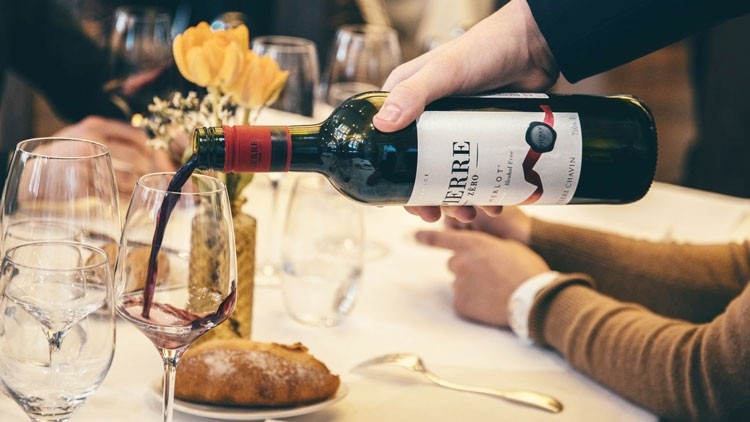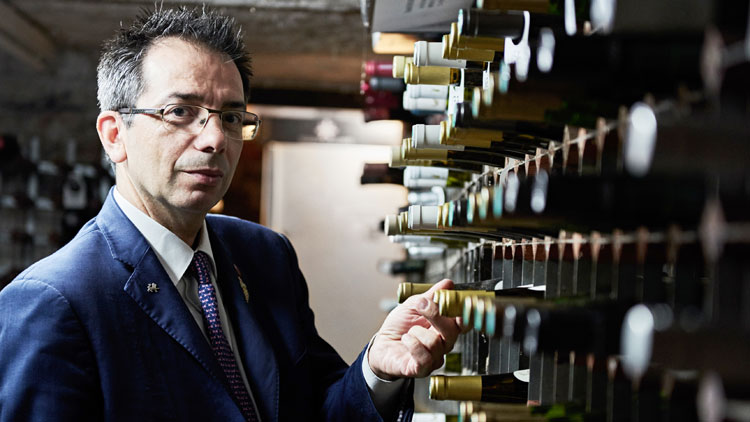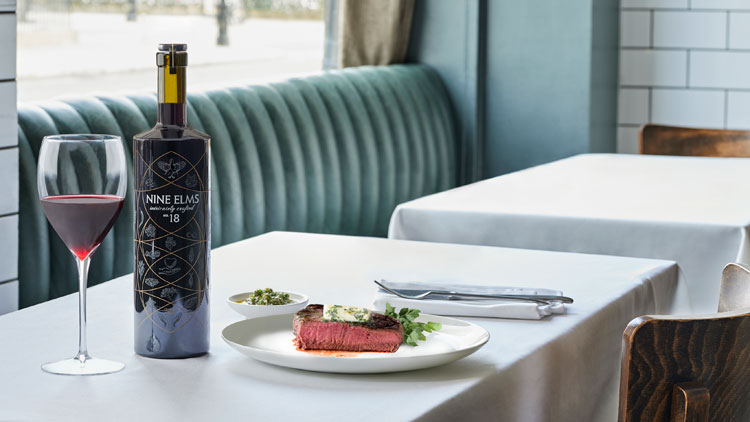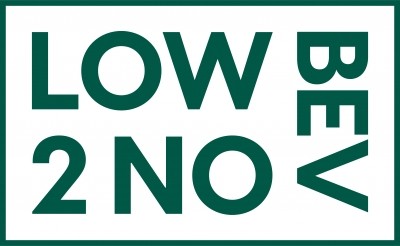Will low- and no-alcohol wines ever be able to cut it in top dining rooms?

Yet higher-end restaurants have a lot more to lose from people drinking less than their more casual counterparts, with wine the principle profit generator in most establishments. The question is, can low-/no-alcohol wines and wine alternatives ever fill the gap when it comes to fine dining?
Those producers in the vanguard believe it has its place, but there are many sommeliers and operators who are less sure. As such, rather than stand up as an equal to wine, alcohol-free alternatives sit in a category of their own.
“It feels a separate product and needs to position itself in that way to become relevant,” says Hawksmoor Group wine buyer Mark Quick, who is yet to stock any low- or no-abv wines. “Sommeliers are after wine that is as true to the terroir as possible – de-alcoholising is not exactly on that agenda.”
Sara Sanabria, marketing director at Familia Torres, the maker of de-alcoholised Torres Natureo, says it is important to understand that de-alcoholised wine does not compete with a classic wine. Instead, it competes with the alternatives when a diner can’t drink a classic wine, many of which are not always designed to match with food.
Sergio Dossantos, head sommelier at The Montagu Arms Hotel in the New Forest, shares this sentiment, adding that no- and low-alcohol wines attract a different audience.
“They will never replace the real thing,” he says. “What they can do is provide an alternative for those looking for a healthier choice, or those who do not drink, that is more exciting than an average soft drink.”
So, what is it about alcohol-free wines that means they can’t replace the ‘real thing’? The problem, says Hawksmoor’s Quick, is mouthfeel. “Alcohol is a big part of the mouthfeel of a drink and considerably changes the flavour profile and the way other sensations such as bitterness and sweetness are perceived,” he says. “My theory is that as wine has so much more alcohol to strip out [than beer], you lose more of the character of what we know of as wine. What do you replace that with?”
Torres Natureo and French producer Pierre Chavin’s Pierre Zéro remove alcohol via the spinning cone column technique – a vacuum distillation process that uses steam to separate volatile compounds. “When you take out alcohol from wine, you profoundly change the aroma and texture balance,” explains Sanabria. She says the process can leave behind a lot of acid and ideally work needs to have taken place in the vineyard and winery to “control the acidity and the residual sugar from the very beginning”.
“The spinning cone column is a physical method to remove alcohol; it is the most natural way to do it,” she adds. At The Montagu Arms, Dossantos is a fan of Torres Natureo’s Muscat. “You still get lots of flavour as Muscat is quite an aromatic grape variety and this producer is very reliable,” he says.
Wine alternatives
Away from de-alcoholised wine, other producers look to claim their place at the table using spices and botanicals. Nine Elms No.18, for example, is a blend of aronia, black cherry, grape and blackcurrant juices that are then aromatised with distilled extracts of around 20 different botanicals. The product is billed to be ‘specifically designed to complement good food’.
Low- and no-alcohol specialist James Morgan, who looks after business development at Nine Elms, believes well-made wine alternatives can make for satisfying food pairings. “The tannin, acidity and complexity found in Nine Elms No.18 make it an ideal match for many foods,” he says.
Nine Elms No.18 is available at The Clove Club in east London, where head sommelier Oliver Christie says it is served with “a lot with main courses, especially dark meat dishes and game”, which lend themselves to the drink’s spiced notes. “It’s round, slightly sweet” and akin to a red wine, he adds.
The Clove Club also blends Nine Elms with Darjeeling tea and serves the drink in a wine glass. Nine Elms’ Morgan says presentation is an important consideration, highlighting a recent experiment with burgundy and bordeaux glasses at 67 Pall Mall. “The difference was marked,” he says. “Black fruit and minty aromas were pronounced in the bordeaux glass, and lovely red fruit and earthy notes came to the fore in the burgundy glass.”
Raising the price points
At the moment, Morgan anticipates seeing Nine Elms on restaurant lists “for around £7-£9” per glass. But as the understanding and acceptance of this new category increases over time, he says “good quality and rewarding drinks” can be sold at £10.
At producer Pierre Chavin, Anne-Lise Kervarec, global marketing manager, also believes it is possible to sell wine alternatives at the £10 mark. “Within the Pierre Zéro range, we have two, more premium wines that were partially aged in oak to develop more complexity,” she says. “Non-alcoholic wine can also be used in premium mocktails, with fresh ingredients, upgrading the price point.”
Kervarec underscores Pierre Zéro’s association with the Ferrandi culinary school in France, as well as the wine’s place on the table at last year’s Nobel Prize banquet. “Offering these alternative wines on a restaurant menu can help develop incremental sales,” she adds.
The Clove Club’s Christie also believes it is possible to make decent margins on non-alcoholic offers. “You can make good margins but obviously the cashflow is much lower,” he explains. “For example, people will pay £145 for a tasting menu with wine but not for one with tea.”
Hawksmoor’s Quick believes that if a product is of a high enough quality, consumers will be willing to pay. “I don’t think people equate alcoholic content with price so much any more,” he says.
There are also some practical reasons why a low- or no-alcohol wine might need to cost more, he points out. “With these wines having a short shelf life, and demand being lower, the restaurant would need to use a preservation system, and this would cause an increase in price,” says The Montagu Arms’ Dossantos. “Whether a restaurant chooses to stock these wines would very much be down to the sommelier because of the logistics of serving low quantities.”
Elsewhere though, hitting the £10-per-glass mark feels unrealistic. Alexandru Pastrav, head sommelier at Fenchurch restaurant Sky Garden, lists alcohol-free Béres Tokaji Furmint Must from Hungary at just £3.95 per 175ml glass and £24 per bottle. He believes £10 is “often too expensive for a non-alcoholic wine”.
The future of low abv wines
If low- and no-alcohol wines' competition is not wine itself but other alcohol-free alternatives, The Clove Club’s Christie believes there are better options available to diners. “There are so many more opportunities to do non-alcoholic pairings,” Christie says, highlighting the venue’s ambient tea offer, which is priced at £50 a head.
When it comes to no-/low-abv wine, he doesn’t see a bright future. “It will never take off, I’ve yet to try one I like,” he says. “But there is a huge future for low/no alcohol pairings – especially
as the younger generation isn’t drinking as much.”
Ultimately, wine is still seen as a treat for many customers, points out Fenchurch’s Pastrav. He says people often still associate higher alcohol levels with a “more sophisticated and pleasant-tasting product”. However, he believes that if more well-known brands start producing low-alcohol wines, “the perception will change and top-end restaurants and sommeliers will start listing and promoting these wines”.
“There is a trend today for responsible drinking and an interest in consuming wine with fewer calories, which is a main driver for the growing interest in this sector,” he says. “The biggest potential for growth is among regular wine drinkers willing to cut down their alcohol intake, or among customers conscious of their diet and calories.”
At Hawksmoor, Quick is also cautiously optimistic about the category’s future at the table: “Low-alcohol wine, or at least what I have come across, is not a valid alternative for ‘traditional’ wine. But that is not to say I think it won’t ever get there,” he says.
Overall, Quick believes we are heading towards an industry “indistinguishable from the one we work in now” with regards to how low-alcohol beverages are perceived. While the jury is out on whether low- and no-alcohol wines can ever replace the real thing, one thing is certain: consumer tastes have changed.
Low 2 No Bev is a new event taking place on 17-18 June 2020 at The Old Truman Brewery in London. For more details visit www.low2nobev.com












